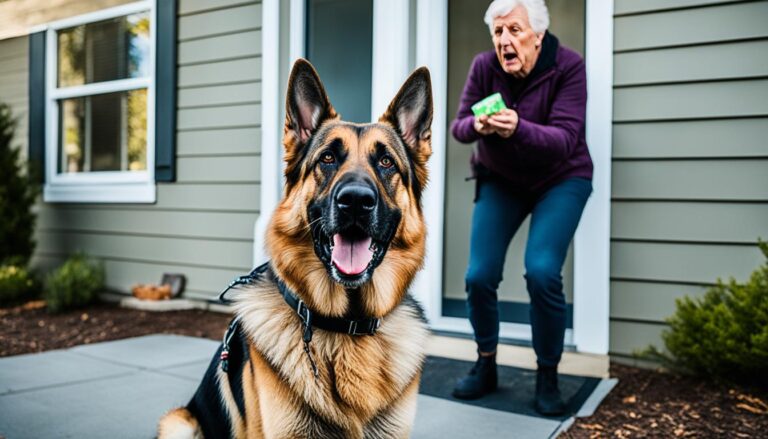How to Train My Dog to Stop Barking at Everything
Do you find yourself constantly dealing with your dog’s incessant barking? It can be incredibly frustrating, not to mention disruptive to your household and neighbors. I know this struggle all too well.
Meet Bella, my energetic and lovable Labrador Retriever. She used to bark at anything and everything that caught her attention – the doorbell, the mailman, birds chirping outside the window, you name it. It felt like there was no end to her barking frenzy, and it was driving me crazy.
But I was determined to find a solution. I dove into researching dog training techniques to help me tackle Bella’s excessive barking. And let me tell you, it was a journey of trial and error. I tried various methods, some more successful than others, until I finally found the ones that worked for Bella.
Now, I want to share my experience and knowledge with you so you can train your dog to stop barking at everything. Whether you have a chatty Chihuahua or a vocal Vizsla, these dog training techniques will help you regain peace and quiet in your home.
Before we dive into the specific techniques, it’s important to understand that dog training requires patience and consistency. Results may vary depending on your individual dog, but with dedication and the right approach, you can make a positive change in your dog’s barking behavior.
Understanding Why Dogs Bark
Dogs bark as a means of communication, expressing their needs, emotions, and alerting their owners to potential threats. However, excessive barking can become a nuisance and disrupt the harmony of your household. To effectively train your dog to stop excessive barking, it is crucial to understand the root cause behind their behavior.
There are various reasons why dogs bark, and each situation may require a different approach to modification. Here are some common reasons why dogs bark:
- Territorial Barking: Dogs often bark to protect their territory and establish boundaries. This type of barking can occur when strangers or other animals encroach upon their perceived territory.
- Alarm Barking: Dogs may bark excessively in response to perceived threats or unfamiliar noises. This type of barking is their way of alerting you to potential danger.
- Attention-Seeking Barking: Dogs may bark to seek attention from their owners when they are feeling lonely, bored, or simply want to engage in play.
- Greeting Barking: Dogs may bark when they want to greet people or other pets, expressing their excitement or enthusiasm.
- Compulsive Barking: Some dogs develop compulsive behaviors, including excessive barking, which may be a result of anxiety, fear, or boredom.
- Socially-Facilitated Barking: Dogs are social animals and may start barking when they hear or see other dogs barking. This type of barking is often triggered by the presence of other dogs.
- Frustration-Induced Barking: Dogs may bark out of frustration when they are unable to access something they desire, such as food, toys, or attention.
To effectively modify a dog’s barking behavior, it is important to identify the specific cause behind their excessive barking. By understanding why your dog is barking, you can then implement appropriate training techniques and behavior modification strategies to address the root cause and help them learn alternative ways of communication.
Prevention and Removing Motivation
Preventing excessive dog barking is essential for a peaceful and harmonious home environment. It requires keeping your furry friend stimulated and occupied. Regular exercise and mental stimulation play a crucial role in reducing barking behaviors.
Identifying the root cause of your dog’s barking is key to effectively training them to stop. Understanding what motivates your dog to bark and working on removing that motivation can make a significant difference. For example, if your dog barks at people passing by the window, a simple solution like closing the curtains or relocating your dog to another room can help manage their barking behavior.

Keeping Your Dog Busy
- Provide daily physical exercise, such as walks, runs, or playtime at the park.
- Engage your dog in interactive play with toys that challenge their mental abilities.
- Consider puzzle toys or treat-dispensing toys that provide mental stimulation.
Removing Motivation for Barking
- Identify the triggers that prompt your dog to bark excessively.
- Modify the environment to prevent access to the triggers.
- Use positive reinforcement by rewarding your dog’s calm behavior.
By taking these preventive measures and removing the motivation for excessive barking, you can create a more peaceful and enjoyable living space for both you and your furry companion.
Desensitization and Use of Commands
Desensitization can be a helpful technique to reduce barking in dogs. By gradually exposing your dog to the stimuli that trigger their barking and rewarding calm behavior, you can help them become desensitized and learn alternative ways to respond.
For example, if your dog barks at strangers passing by, you can start by having a friend walk by at a distance, and gradually decrease the distance over time. Reward your dog with treats or praise when they remain calm. This process helps them associate the trigger with positive experiences and reduces their need to bark.
In addition to desensitization, training your dog with commands can be effective in curbing excessive barking. One useful command to teach your dog is “quiet.” Here’s how to do it:
- Wait for a moment when your dog is barking.
- Approach your dog with a calm tone of voice and say “quiet” firmly.
- As soon as your dog stops barking, praise and reward them with a treat.
- Repeat this process consistently, gradually increasing the duration of quiet behavior before giving the reward.
Using positive reinforcement training, such as treats or praise, helps your dog associate the command and desired behavior with something enjoyable. It is important to be patient and consistent throughout the training process.
Remove the Offending Object and Anti-Stress Devices
In some cases, the key to stopping your dog from excessive barking lies in removing the triggering stimulus. By eliminating the sight or sound of the object or situation that sets off your dog’s barking, you can effectively manage their behavior. For example, if your dog barks at squirrels in the backyard, simply closing the blinds or curtains can prevent them from getting worked up and reduce the barking.
In addition to removing the offending object, you can also consider using anti-stress devices to help calm your dog and alleviate their barking. Stress-reducing collars and anxiety wraps are popular options that can provide a sense of security and comfort to your furry friend. These devices work by applying gentle pressure to your dog’s body, promoting relaxation and reducing anxiety.

Overall, removing the triggering object and introducing anti-stress devices can be effective strategies to reduce excessive barking in dogs. By eliminating the source of their agitation and providing them with a calming solution, you can help your furry companion find peace and quiet.
Alleviating Boredom and Dog Bark Spray Collar
Dogs can become bored easily, and boredom often leads to excessive barking. To alleviate boredom in dogs, it is important to provide them with plenty of physical and mental exercise. Regular activities such as walks, runs, and playtime in the park can help keep your dog active and engaged.
Another effective way to alleviate boredom is by offering interactive dog toys and puzzles. These toys can mentally stimulate your dog and keep them occupied, reducing the likelihood of excessive barking. Consider investing in puzzle toys that dispense treats or require problem-solving skills to entertain your furry friend.
In some cases, a dog bark spray collar can be used to deter excessive barking. These collars emit a harmless mist of liquid when the dog barks, distracting them from barking further. This can help break the cycle of barking and redirect their attention to more appropriate behaviors.
It’s important to note that while a dog bark spray collar can be an effective tool, it should be used responsibly and in conjunction with positive reinforcement training methods. The collar should only be used as a temporary training aid to help modify barking behavior, and it should never be used as a substitute for addressing the underlying causes of excessive barking.
Hiring a Professional Trainer
If you’ve tried various techniques and methods to train your dog to stop barking but haven’t seen the desired results, it may be time to consider hiring a professional dog trainer. A professional trainer has the necessary expertise in behavior modification and can create a customized training plan based on your dog’s specific needs.
Working with a professional trainer offers several advantages. Firstly, they can help you identify and address the underlying causes of your dog’s barking behavior. This can be crucial in effectively modifying their behavior and preventing excessive barking in the future. Additionally, a professional trainer can provide you with valuable insights and techniques that you may not have considered before.
During the training sessions, the trainer will work closely with you and your dog to teach them alternative behaviors and responses to triggers that typically lead to barking. They will employ positive reinforcement techniques, rewarding your dog for calm and quiet behavior. This positive approach encourages your dog to associate calm behavior with rewards, reinforcing the desired behavior.
Remember, every dog is unique, and what works for one dog may not work for another. A professional trainer will take the time to understand your dog’s individual personality, temperament, and triggers, tailoring the training program accordingly. This personalized approach increases the likelihood of success in reducing your dog’s barking behavior.
When hiring a professional dog trainer, it’s important to choose someone who is experienced, certified, and uses positive reinforcement methods. Look for trainers who have a solid reputation and positive reviews from previous clients. You can ask for recommendations from friends, family, or your veterinarian. Additionally, consider scheduling a consultation with the trainer to see if their training philosophy aligns with your goals.
By enlisting the help of a professional trainer, you can effectively address your dog’s barking behavior and establish a peaceful living environment for both you and your furry friend. With their expertise and guidance, you’ll gain valuable insights and techniques that will make the training process more effective and enjoyable for both you and your dog.
Conclusion
Training your dog to stop excessive barking can be a challenging but rewarding endeavor. It requires time, patience, and consistency to address the underlying causes of the barking behavior. By understanding why your dog barks and implementing appropriate training techniques, you can effectively reduce excessive barking and create a more peaceful environment for both you and your furry friend.
One of the key training tips for dog barking is to focus on positive reinforcement. Rewarding your dog for calm behavior and teaching them alternative behaviors can be more effective than using harsh punishment methods. Use treats, praise, and playtime as rewards when your dog demonstrates desired behavior, such as staying quiet when prompted or redirecting their attention away from triggers.
Additionally, consistency is crucial in training your dog to stop excessive barking. Set clear boundaries and consistently reinforce them. Use consistent commands like “quiet” or “enough” to signal your dog to stop barking. Be patient and give your dog time to learn and adjust their behavior. Remember that every dog is unique, so what works for one may not work for another. Stay consistent and adaptable in your training methods.
Lastly, if you’re struggling to make progress or are unsure how to tackle your dog’s excessive barking, don’t hesitate to seek the help of a professional dog trainer. They have the knowledge and experience to assess your dog’s behavior and provide customized training plans. A professional trainer can guide you through the training process, offer valuable insights, and help you achieve your goal of reducing excessive barking.






